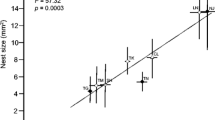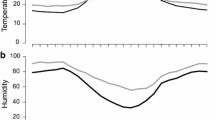Summary
-
1.
The data available on the behaviour associated with stridulation in the following four species of Acrididae are summarized:S. lineatus, O. viridulus, C. parallelus andC. brunneus.
-
2.
These data are discussed in relation to the ecology of the insects in particular colonies in England, with reference to effects on mating, predation, oviposition and small and large scale movements in the field.
-
3.
It is postulated that stridulation behaviour plays a dual role in relation to the ecology of the grasshoppers; it promotes meeting of the sexes and forms the basis of courtship and copulation behaviour and, secondly, it serves to maintain the grouping of a colony and to prevent dispersion of the latter during movement occurring in relation to changes in the vegetation of the habitat.
Sommaire
-
1.
On étudie dans la présente note le comportement accompagnant la stridulation, chez les quatre espèces suivantes d'Acrididæ:S. lineatus, O. viridulus, C. parallelus, C. brunneus.
-
2.
On discute ces comportements en fonction de l'écologie des Insectes observés dans des populations anglaises particulières; on s'attache plus spécialement à décrire la stridulation au cours de la période, du comportement alimentaire, de l'oviposition et des déplacements de plus ou moins grande amplitude dans la campagne.
-
3.
On considère que la stridulation joue un rôle dans l'écologie des Criquets: elle amène la rencontre des deux sexes et constitue la base de la pariade et de l'accouplement, elle sert à maintenir la cohésion d'une colonie et prévient sa dispersion pendant les mouvements liés aux modifications de la végétation de l'habitat.
Zusammenfassung
-
1.
In dieser Besprechung des Verhaltens von Heuschrecken im Zusammenhang mit der Stridulation werden folgende vier Arten angeführt:S. lineatus, O. viridulus, C. parallelus andC. brunneus.
-
2.
Die Beobachtungen werden erörtert mit Bezug auf die Okologie dieser Insekten in gewissen “Kolonieen” in England, mit Hinsicht auf Paarung, Räubertum, Eiablage, und großen und kleinen Bewegungen im Freiland.
-
3.
Die Theorie wird aufgestellt daß das Stridulationsverhalten eine zweifache Rolle in der Ökologie der Heuschrecken spielt; i) es fördert das Auffinden zwischen Männchen und Weibchen und bildet die Grundlage für Balz und Kopulation; ii) es verhilft einer Kolonie ihre Gruppierung zu erhalten und verhütet ihre Zerstreuung wenn Bewegungen bezüglich Anderungen in der Vegetation des Fundortes stattfinden.
Similar content being viewed by others
References
1953.Busnel (R.-G.), Loher (W.). — Recherches sur le comportement de divers Acridoidea mâles soumis à des stimuli acoustiques artificiels. (C. R. Acad. Sci., Paris,237, 1557–1559).
1952.Chapman (K.). — Ecological studies on solitary Acrididæ in England and South Africa (J. ent. Soc. S. Afr.,15, 165–203).
1948.Clark (E. J.). — Studies in the ecology of British grasshoppers (Trans. R. ent. Soc. Lond.,99, 173–222).
1955.Dempster (J. P.). — Factors influencing small-scale movements of some British grasshoppers (Proc. R. ent. Soc. Lond., (A),30, 145–150).
1933.Diver (C.), Diver (P.). — Contributions towards a survey of the plants and animals of South Haven Peninsula, Studland Heath, Dorset. III. Orthoptera. (J. Anim. Ecol.,2, 36–69).
1957.Ellis (P. E.), Ashall (C.). — Field studies on diurnal behaviour, movement and aggregation in the Desert Locust (Schistocerca gregaria Forskal) (Anti-Locust Bull., No.25, 94 p.).
1932.Faber (A.). — Die Lautäusserungen der Orthopteren II. Untersuchungen über die biozönotischen, tierpsychologischen und vergleichend-physiologischen Probleme der Orthopterenstridulation. Methodik der Bearbeitung und Auswertung von Stridulations-beobachtungen (Einzeldarstellungen) (Z. Morph. Okol. Tiere,26, 1–93).
1933.Fulton (B. B.). — Inheritance of song in hybrids of two subspecies ofNemobius fasciatus (Orthoptera). (Ann. ent. Soc. Amer.,26, 368–376).
1929.Grassé (P.-P.). — Étude écologique et biogéographique sur les Orthoptères français (Bull. biol.,63, 489–539).
1938.Harvey (L. A.). — Preliminary note on the relations between grasshoppers and the recolonisation of denuded heath-and moor-land vegetation (Trans. Soc. Brit. Ent.,5, 291–297).
1955a.Haskell (P. T.). — Vibrations of the substrate and stridulation in a grasshopper (Nature, Lond.,175, 639–640).—Haskell (P. T.) 1955b. Intensité sonore des stridulations de quelques Orthoptères britanniques [In Busnel (R.-G.), éd.]. Colloque sur l'Acoustique des Orthoptères [Ann. Epiphyt. (fasc. hors sér.), 154–167].—Haskell (P. T.) 1956a. Hearing in certain Orthoptera. I. Physiology of sound receptors (J. exp. Biol.,33, 756–766).—Haskell (P. T.) 1956b. Hearing in certain Orthoptera. II. The nature of the response of certain receptors to natural and imitation stridulation (J. exp. Biol.,33, 767–776). —Haskell (P. T.) 1957a. Stridulation and associated behaviour in certain Orthoptera. I. Analysis of the stridulation of and behaviour between males [Brit. J. Anim. Behav.,5, 139–148].—Haskell (P. T.) 1957b. Stridulation and its analysis in certain Geocorisæ (Hemiptera Heteroptera) [Proc. zool. Soc. Lond. 129, 351–358].—Haskell (P. T.) 1958. Stridulation and associated behaviour in certain Orthoptera. II. Stridulation of females and their behaviour with males [Anim. Behav.,6, 27–42].
1950.Jacobs (W.). — Vergleichende Verhaltensstudien an Feldheuschrecken (Z. Tierpsychol.,7, 169–216).—Jacobs (W.) 1953. Verhaltensbiologische Studien an Feldheuschrecken (Z. Tierpsychol., Beiheft1, 1–228).—Jacobs (W.) 1955. Problèmes relatifs à l'étude du comportement acoustique chez les Orthoptères [In Busnel (R.-G.), éd.].—Jacobs (W.) 1955. Colloque sur l'Acoustique des Orthoptères [Ann. Epiphyt. (Fasc. hors sér.), 307–318].
1951.Kennedy (J. S.). — The migration of the Desert Locust (Schistocerca gregaria Forsk.). I. The behaviour of swarms. II. A theory of long-range migrations [Phil. Trans., (B),235, 163–290).
1945.Key (K. H. L.). — The general ecological characteristics of the outbreak areas and outbreak years of the Australian Plague Locust (Chortoicetes terminifera Walk.) (Bull. Coun. Sci. industr. Rest. Aust., no.186, 1–127).
1939.Klingstedt (H.). — Taxonomic and cytological studies on grasshopper hybrids. I. Morphology and spermatogenesis ofChorthippus bicolor Charp. XCh. biguttulus L. (J. Genet.,37, 389–420).
1957.Leston (D.). — Sound production in Hemiptera Heteroptera. Stridulatory mechanisms in terrestrial species [Proc. zool. Soc. Lond. 128, 369–386].
1924.Lutz (F. E.). — Insect sounds (Bull. Amer. Mus. nat. Hist.,50, 333–372).
1955.Marler (P.). — Characteristics of some animal calls (Nature, Lond.,176, 6–8).
1929.Myers (J. G.). — Insect Singers (A natural history of the cicadas). London, George Routledge et Sons Ltd., 304 p.).
1949.Ossiannilsson (F.). — Insect drummers (Opusc. Ent., Suppl.,10, 1–145).
1896.Poulton (E. B.). — On the courtship of certain European Acrididæ (Trans. ent. Soc. Lond., 233–252).
1932.Randon (J.). — Les groupements d'Orthoptères du Bas-Languedoc (Bull. biol.,66, 1–44).
1923.Regen (J.). — Uber die Orientierung des Weibchens vonLiogryllus campestris L. nach dem Stridulationsschall des Männchens [S. B. Akad. Wiss. Wien (1),132, 81–88].—Regen (J.) 1930. Über den Aufbau der Stridulationslaute der saltatoren Orthopteren [S. B. Akad. Wiss. Wien (1),139, 539–544].
1954.Richards (O. W.), Waloff (N.). — Studies on the biology and population dynamics of British grasshoppers (Anti-Locust Bull., no.17, 182 p.).
1932.Rubtzov (I. A.). — The habits and conditions of grasshopper outbreaks in East Siberia (In Russian with English summary) [Bull. Pl. Prot. Leningr. (1), no.3, 33–130].—Rubtzov (I. A.) 1935. Regularities in the development and behaviour of Siberian Acrididæ in connection with climatic factors (In Russian with German summary) (Bull. Acad. Sci. U. R. S. S., no.5, 789–824).
1957.Uvarov (B. P.). — The aridity factor in the ecology of locusts and grasshoppers of the Old World (In Arid Zone Research. VIII. Human and Animal Ecology. Paris, UNESCO, 164–198).
1951.Weih (A. S.). — Untersuchungen über das Wechselsingen (Anaphonie) und über das angeborene Lautschema einiger Feldheuschrecken (Z. Tierpsychol.,8, 1–41).
Author information
Authors and Affiliations
Rights and permissions
About this article
Cite this article
Haskell, P.T. The relation of stridulation behaviour to ecology in certain Grasshoppers. Ins. Soc 5, 287–298 (1958). https://doi.org/10.1007/BF02223938
Issue Date:
DOI: https://doi.org/10.1007/BF02223938




